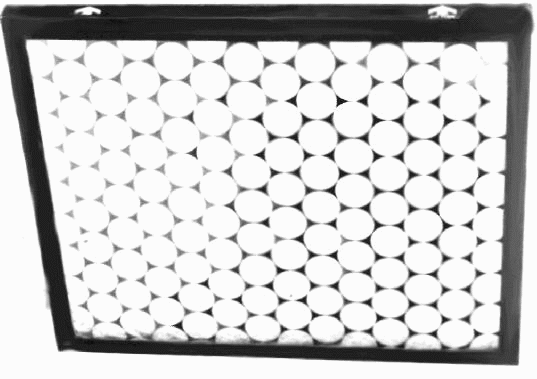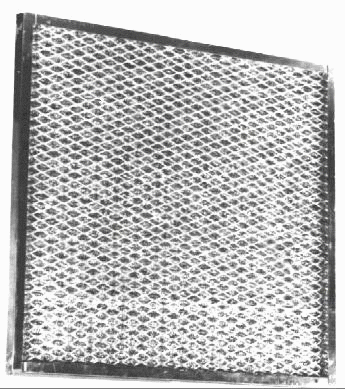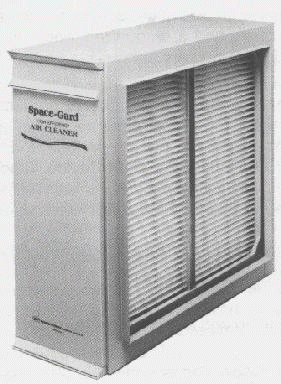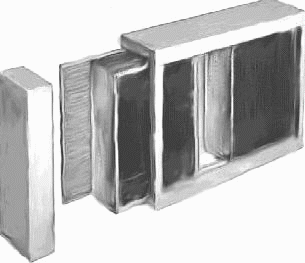FILTER SIZING
- GOAL:
- To become aware of the need for proper air filter sizing.
- OBJECTIVES:
- Students will be able to:
- 1. Understand energy waste due to improper filter sizes
- 2. Properly size return air filters.
- LESSON / INFORMATION:
- All of the air which enters the HVAC system enters through the return air filter. The filter must be theoretically sized according to the cfm (cubic feet per minute) requirement of the system. A filter that is too small will cause a number of problems. The filter will clog very rapidly if undersized and reduce air flow. Air velocity also becomes critical with reduced size and dirt will pass through instead of staying in the filter. The dirt will eventually get to the blower wheel and reduce surface area or on the evaporator coil and restrict air flow. A filter and grill that are too small will vibrate and whistle, which can be annoying. The system is trying to draw in the designed air quantity and if the filter will not allow flow, air will be drawn in from any possible crack. Every system, no matter how air tight you construct it, will have small cracks through which dirty, warm air will enter the system as static pressure increases. A large surface area filter will negate the effect of these cracks by having a lower static pressure and lower air velocity.
- The recommended minimum filter surface area is 2.50 cubic feet per minute (cfm) per square inch of filter area.
- Example 1:
- 2000 cfm ÷ 250 inches = 800 square inches or 20" X 40" filter grill.
- The maximum allowable filter velocity is 300 feet per minute (fpm) on disposable filters. The above example would yield 360 fpm and a disposable filter could not be used. For best results, use 2.00 cubic feet per minute per square inch of filter area.
- Example 2:
- 2000 ÷ 200 inches = 1000 square inches of 40" X 24" filter. Usually two grills 20" X 25" each would be used.
- The second formula works in all residential applications. Using 2.00 cfm per square inch the velocity of air across the filter will not exceed 300 fpm in 1 through 5 ton units.
- In applications of limited space, the disposable filter may be located in the return duct. When using duct mounted filters, consult the manufacturer's literature on the return grill sizing to prevent noise and reduce restrictions.
- In residential applications, we find many types of air filters:
- Figure 1. Disposable Filter

- Figure 2. Washable Permanent Filter

- Figure 3. Media Type Filter

- Figure 4. Electronic Air Filter

- The Media type is more efficient than the disposable and the electronic type removes particles to .1 micron.
- ACTIVITY:
- Demonstrate effects of reduced filter area with a 1200 cfm blower connected to a 20" X 30" filter grill housing with a standard 20" X 30" disposable filter.
- 1. Set up blower, measure and record motor RPM amp draw.
- 2. Measure and record air velocity and volume.
- 3. Block off surface area of filter grill with cardboard or comparable material - 20" X 20".
- Measure and record:
- A. Motor RPM ________
- B. Motor Amp Draw ________
- C. Air Velocity ________
- D. Air Volume ________
- E. Noise Level ________
- 4. Block off the surface area as in step 3 to 20" X 15".
- Measure and record:
- A. Motor RPM _______
- B. Motor Amp Draw ________
- C. Air Velocity ________
- D. Air Volume ________
- E. Noise Level _________
- 5. Block off the surface area as in step 3 to 20" X 10".
- Measure and record:
- A. Motor RPM _______
- B. Motor Amp Draw ________
- C. Air Velocity ________
- D. Air Volume ________
- E. Noise Level _________
Comments or questions to: TechAsmt@LA.GOV
Return to HVAC Menu







